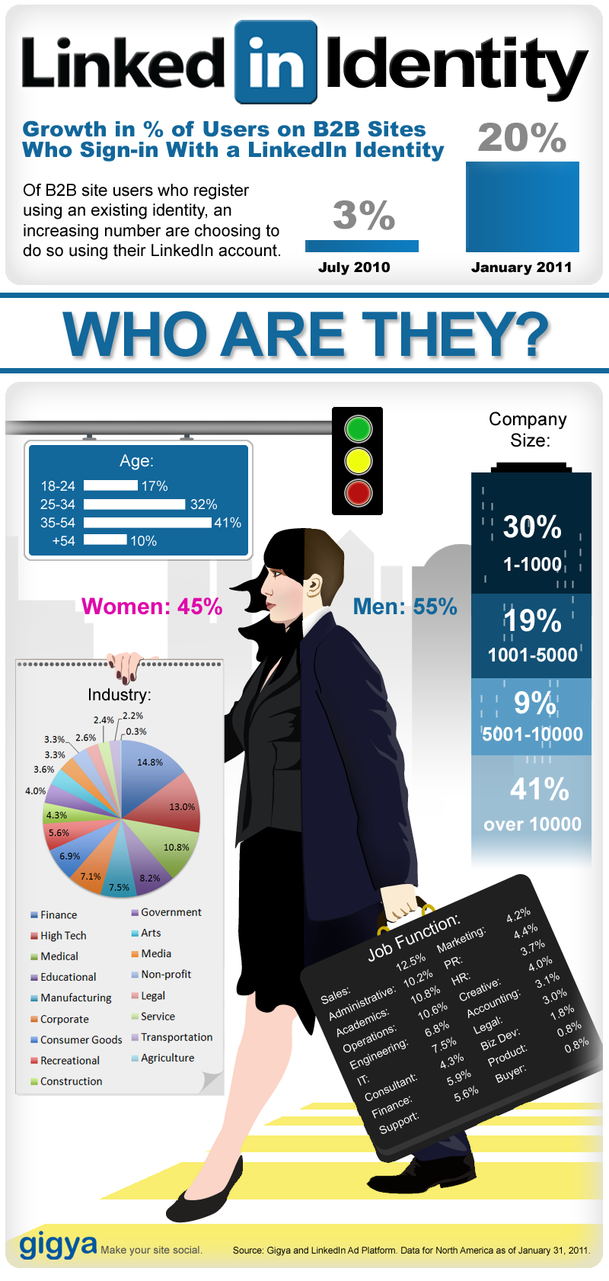riteWeb reports that Gigya, a provider of tools for social sharing and third-party logins, assessed the numbers and found that, since its last round-up of social logins in July 2010, LinkedIn has skyrocketed as the login of choice for B2B sites.
These figures confirm the notion that users prefer to use differing online identities for certain online activities, making use of multiple online personalities. Users wish to promote the right image of themselves according to who might see their profile, and LinkedIn is all about promoting professional self identity. Therefore it makes sense not to use a more personal Facebook or Twitter login.
The LinkedIn login JavaScript API makes it easy to let third party website customers authenticate via their LinkedIn account. The third party site can then use that information to register those users for their own site, identify them in a blog comment, or otherwise use the login to streamline their experience. This provides the third party website with increased registrations with minimal work.
The most important piece of data for third parties to capture and store is the LinkedIn member id. This is an application-specific unique identifier for every member and with this identity, third parties can easily retrieve profile information about any of their users who have authenticated using Sign In with LinkedIn.
Rachel Peterson, a spokesperson for LinkedIn, commented that the company has seen increased use as a third-party login ever since it updated its profile API. The site has seen an increase from 3% to 20% in just over six months.
“LinkedIn has a strong case that a single social graph through Facebook is not sufficient,” said Peterson. “Professionals want to apply different profile data to business oriented sites and share that content with a different group of people than their FB friends.”
This doesn’t mean that LinkedIn is a growing threat to the giant that is Facebook, however, but shows a coming of age of social media where savvy users are beginning to understand when and how to use each network.
Facebook is still used predominantly as a meeting place for family and friends, and businesses can use the platform to listen to those conversations and participate on a more personal level.
LinkedIn however has found its niche, making sense as a business identity, as it is more restrictive, and is not as successful as Facebook and Twitter in terms of two-way interaction. The company reports that it has 90-million users worldwide (just over a third are U.S. based), of which 7.9-million are business decision makers, 1.3-million are small business owners, 5.5-million are high tech managers and 4.4-million are corporate executives.
LinkedIn is essentially used by people as a digital CV in order to attract job offers, or to exchange information about businesses and services. It is by nature a Mecca for self-promotion, which is why it makes sense as login of choice for B2B sites.
What better way to garner the attention of other professionals in your line of work?

These figures confirm the notion that users prefer to use differing online identities for certain online activities, making use of multiple online personalities. Users wish to promote the right image of themselves according to who might see their profile, and LinkedIn is all about promoting professional self identity. Therefore it makes sense not to use a more personal Facebook or Twitter login.
The LinkedIn login JavaScript API makes it easy to let third party website customers authenticate via their LinkedIn account. The third party site can then use that information to register those users for their own site, identify them in a blog comment, or otherwise use the login to streamline their experience. This provides the third party website with increased registrations with minimal work.
The most important piece of data for third parties to capture and store is the LinkedIn member id. This is an application-specific unique identifier for every member and with this identity, third parties can easily retrieve profile information about any of their users who have authenticated using Sign In with LinkedIn.
Rachel Peterson, a spokesperson for LinkedIn, commented that the company has seen increased use as a third-party login ever since it updated its profile API. The site has seen an increase from 3% to 20% in just over six months.
“LinkedIn has a strong case that a single social graph through Facebook is not sufficient,” said Peterson. “Professionals want to apply different profile data to business oriented sites and share that content with a different group of people than their FB friends.”
This doesn’t mean that LinkedIn is a growing threat to the giant that is Facebook, however, but shows a coming of age of social media where savvy users are beginning to understand when and how to use each network.
Facebook is still used predominantly as a meeting place for family and friends, and businesses can use the platform to listen to those conversations and participate on a more personal level.
LinkedIn however has found its niche, making sense as a business identity, as it is more restrictive, and is not as successful as Facebook and Twitter in terms of two-way interaction. The company reports that it has 90-million users worldwide (just over a third are U.S. based), of which 7.9-million are business decision makers, 1.3-million are small business owners, 5.5-million are high tech managers and 4.4-million are corporate executives.
LinkedIn is essentially used by people as a digital CV in order to attract job offers, or to exchange information about businesses and services. It is by nature a Mecca for self-promotion, which is why it makes sense as login of choice for B2B sites.
What better way to garner the attention of other professionals in your line of work?
